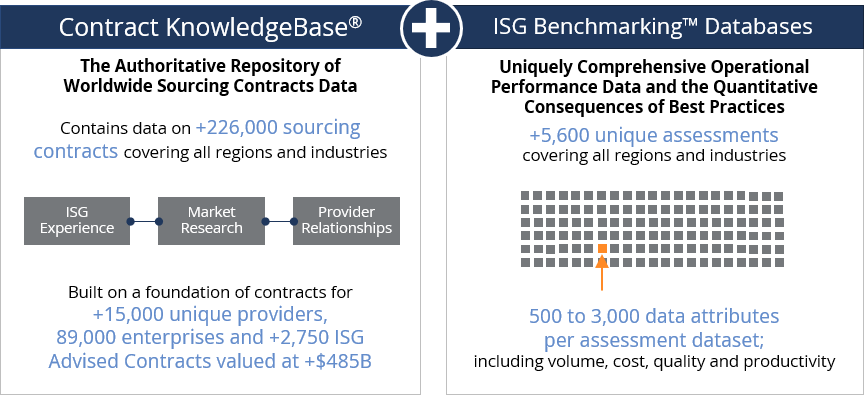5 Ways to Optimize Application Sourcing Costs in an AI-Enabled Market
Application sourcing —software, support, labor and managed services — presents a prime opportunity to reduce spend and improve value realization.



We have +15 years' experience helping enterprise clients compare defined services to the market.
We have the data and know-how to help you benchmark cost, quality and productivity across all functional areas of business and IT, including:
Find out the right benchmarking services for your needs and strategic objectives.

![]()
Price
Staffing rates, contract pricing and competitiveness

Cost
Total cost of ownership (TCO) and industry benchmarks
![]()
Performance
SLAs, user experience and provider relationships

Contract
Price, terms and conditions
Are total staffing levels and staffing utilization right for each functional area?
How do our level of assets compare? Are we providing the right service levels to users?
Are we spending the right amount of money in total, and by major functional area?
Where are the variances from leading practices?
Why and where are there gaps? How do we drive sustainable improvement?
What are the high impact, high ROI changes we can make in the immediate term?
Are there services currently provided in-house that should be outsourced, or vice versa?
What complexity or constraints could be alleviated through automation or simplification?
Outsourcing contracts become uncompetitive over time, but it’s difficult to know when it will happen – or by how much.
Whether you want to benchmark your outsourcing contracts’ price, compare your internal service delivery cost to the market or both, ISG gives you at-a-glance visibility into price competitiveness via a single-pane dashboard, plus access to deep dives into real-time IT industry market price intelligence.
In addition to the above project based price benchmarking services, you can also monitor the price competitiveness of your contracts in real time using using the ISG Probenchmark® price monitoring service.
Acting on timely, accurate and actionable price data allows enterprises to more quickly respond to changes in market prices and make more strategic decisions regarding their IT services.
To get a complete picture of your landscape, you need to understand your service quality and personnel productivity, potential efficiencies and gaps, user satisfaction, and how all these elements relate to cost and compare to the market.
We offer a holistic benchmarking solution that gives real-time, online dashboard visibility into the three key components of performance:
By comparing your spend, staffing allocations and performance across the enterprise, we help you identify opportunities to improve your financial and operational performance.
TCO Benchmark: Compares your total cost of ownership against industry standards of cost, quality and productivity for a variety of IT products and services.
Industry Benchmark: Compares costs against industry metrics, such as IT spend as a percent of revenue.
Get real-time access to cost benchmarking data with ISG Inform™.
Build a defense against the risks of fixed-price long-term contracts. Compare your contract price, terms and conditions to the market and know when your contract falls out of favor.
The terms and conditions of your contracts set guidelines of acceptable behavior, but they are evolving entities – and you need to manage that evolution. A commitment to benchmarking your contracts is a commitment to progress and improvement.
An ISG contract terms and conditions assessment can:
KPIs and SLAs are essential for tracking performance in terms of achieving strategic goals and making decisions. In the best of cases, KPIs can serve as an early warning system to let you know when you are heading off course and where
action might be needed.
An ISG performance benchmark compares your performance against industry peers and leaders and gives you a cost-effective approach to share, compare, improve, and transform internal functions and processes.

SLA Benchmark
assesses service levels against the market, including both performance levels and structure

User Experience Benchmark
measures the impact of technology on users, including customer satisfaction
ISG is a leader in proprietary research, advisory consulting and executive event services focused on market trends and disruptive technologies.
Get the insight and guidance you need to accelerate growth and create more value.
Learn MoreI am struck by the blizzard of software announcements this year describing new features for CX tools that are “agentic,” meaning autonomous tools take actions without (much) human intervention. Industry conversation about agentic AI has proceeded ahead of clarifying definitions and a sense of how it fits on a continuum of rapid AI development.
The IT department of any enterprise is integral to implementing and managing the execution of its data objectives, just as the finance department is integral to implementing and managing financial objectives. Few enterprises would allow the finance department complete autonomy to define financial strategies; however, too many enterprises allow the IT department to define data strategies. Treating data as a business discipline—rather than a technical one—is a critical component of delivering competitive advantage through investment in data processing, analytics and artificial intelligence. This can be facilitated by adopting the most appropriate organizational approach, depending on the data activity.
The need for effective cybersecurity strategies remains a priority as enterprises face ever-increasing complex cyber threats. Nonetheless, the conventional approach in which IT departments, especially Chief Information Officers (CIOs) and Chief Information Security Officers (CISOs), exclusively manage the procurement of cybersecurity software, is showing its limitations. A crucial shift is occurring: Cybersecurity is no longer solely the domain of IT but has become a strategic business imperative. Leaders across different departments, from finance to operations, must appreciate the indispensable role they play in guiding cybersecurity decisions. This Analyst Perspective explores the influences in cybersecurity software procurement beyond IT and security teams, highlighting the necessity for unified communication, collaboration and strategic alignment between technical needs and overarching business goals.
SAP Business Data Cloud (BDC) is the unification of capabilities that previously existed in two separate offerings: SAP Datasphere and SAP Analytics Cloud. As its name implies, Analytics Cloud was SAP’s analytics offering. However, unlike many of its competitors, it also included planning capabilities. SAP Datasphere was the evolution of SAP’s data warehouse as a service (formerly called SAP Data Warehouse Cloud) and included data management, data integration, data federation, data governance and data catalog capabilities.
Our 2025 research divides the workforce-management landscape into five focused guides—WFM Basics, WFM Suites, WFM for Healthcare, WFM for Manufacturing and WFM for Retail. Each report applies a common evaluation lens yet weights criteria to reflect the operational realities, compliance pressures and innovation priorities unique to its scope. Together, they provide a panoramic view of the market and a set of targeted benchmarks that let buyers zero in on the capabilities—and partners—best aligned to their context.

